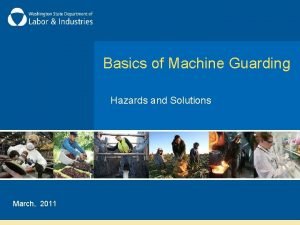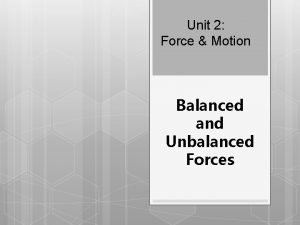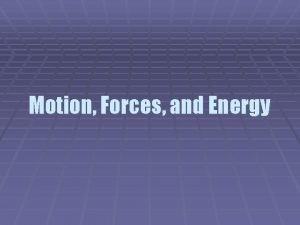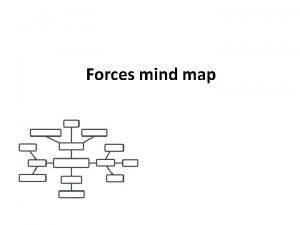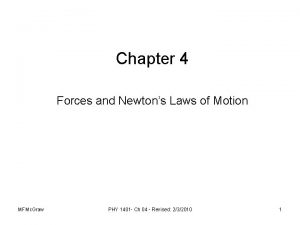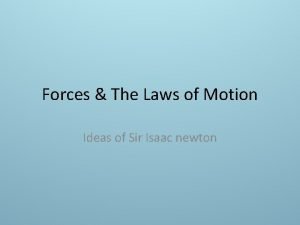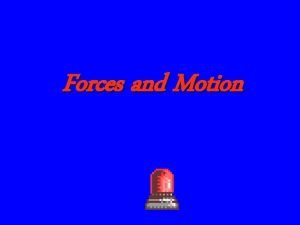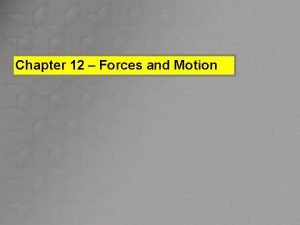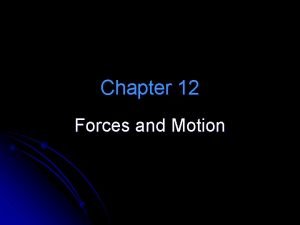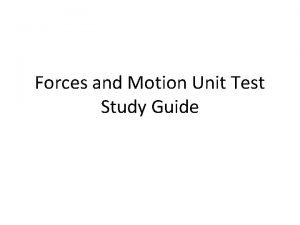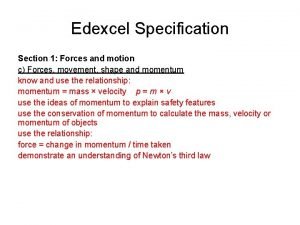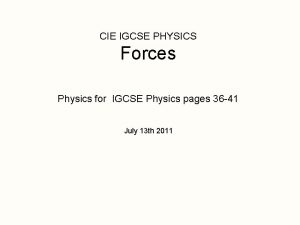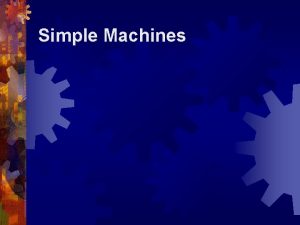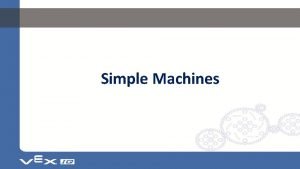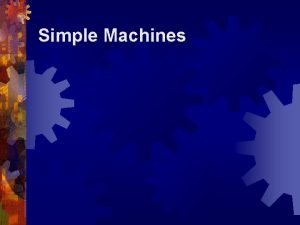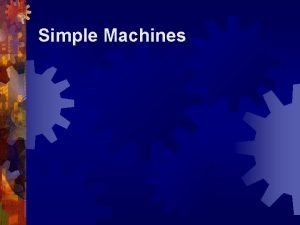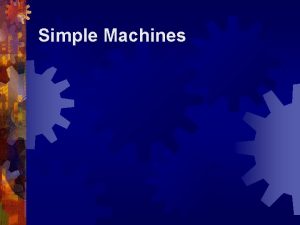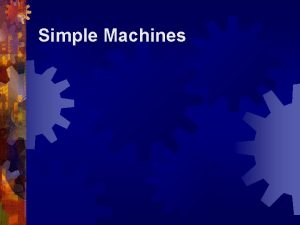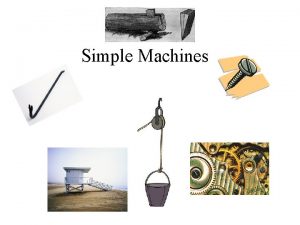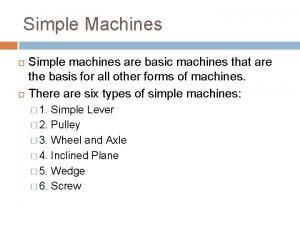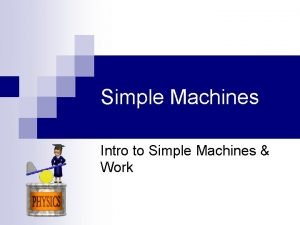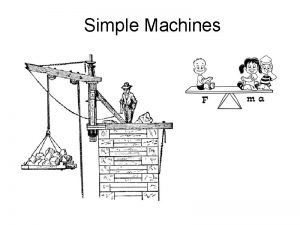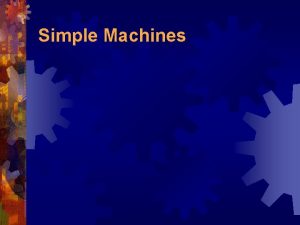Simple Machines Forces and Motion Force is a





















- Slides: 21

Simple Machines

Forces and Motion • Force is a push or a pull. • The amount of force you have to use on an object depends on its mass. • Motion is a change in position. • Every motion is started by a force. • Speed is how fast something moves over a certain distance.

Gravity • Gravity is the force that pulls objects toward each other. • The more mass each object has the more gravity pulls them to each other. • Weight is how we measure the pull of gravity on an object.

Work • Work is the measure of force it takes to move an object a certain distance. • Scientifically work is done only when an object is moved through a distance. • Work=Force * Distance • Joules= Newton * Meter

Machines DO NOT save work How is it that the path from A-C takes the same amount of work as path B-C? In A-C we have to exert a lot of force to get up the vertical side, but we don't have to go very far. Let's suppose that the force required is 100 Newtons and the distance is 4 meters, the amount of work done is 400 Joules: W=F • d W=100 N • 4 m W= 400 J Getting from B-C does not require near as much force as A-C, but we do have to move a considerably longer distance. In fact, the actual force and distance are 25 Newtons and 16 meters. Calculating the work gives: W= 25 N • 16 m W= 400 J

Mechanical Advantage Some machines can increase force more than others. A machine’s mechanical advantage tells you how many times the machine multiplies force. Use the following equation to find mechanical advantage: MA =

Mechanical Efficiency The less work a machine has to do to overcome friction, the more efficient it is. Mechanical efficiency is a comparison of a machine’s work output with the work input. Use the following equation: Mechanical Efficiency = The 100 in the equation means that mechanical efficiency is expressed as a percentage. If a machine could be made that had 100 percent mechanical efficiency, it would be called an ideal machine.

Types of Machines 1. Lever a. First Class Lever b. Second Class Lever c. Third Class Lever 2. Inclined Plane 3. Wedge 4. Screw 5. Wheel and Axle 6. Pulley

Wedge Machine used for slicing; lifts, splits, and holds

Screw A screw is a machine with grooves that winds round and round in a spiral; a screw can also bring or hold materials together.

Pulley • A special kind of wheel that changes the direction of the force. • When you pull down the object goes up. • Can move items up, down, or across.

Fixed Pulleys • This is a fixed pulley. It doesn't move when the rope is pulled. It is fixed to the upper bar. • You can pull down on the rope in order to lift the load up. • A fixed pulley only spins. Therefore, there’s a mechanical advantage of 1.

Movable Pulleys • This is a movable pulley. As the rope is pulled up, it can also move up. The weight is attached to this moveable pulley. Each side of the rope is supporting the weight, so each side carries only half the weight. • The force needed to hold up the pulley in this example is 1/2 the weight! • The mechanical advantage of this system is 2. It is the weight (output force) divided by 1/2 the weight (input force).

More on Pulleys… • When a fixed pulley and a movable pulley are used together, the pulley system is called a block and tackle. You can see that the weight is now suspended by two pulleys rather than one. That means the weight is split equally between the two pulleys, so each one holds only half the weight, or 50 pounds (22. 7 kilograms). That means that if you want to hold the weight suspended in the air, you only have to apply 50 pounds of force (the ceiling exerts the other 50 pounds of force on the other end of the rope).

Wheel and Axle • Wheels are round, and they turn to make things go. • The wheel and axel moves loads. It is one of our most important inventions, essential to transportation.

Inclined Plane (ramp or stairs) A surface, often flat, set at an angle to another surface. Allows items to move up or down.

Lever • a bar that moves on or around a fixed point; lifts or moves loads

Levers A lever is a simple machine consisting of a bar that pivots at a fixed point, called a fulcrum. Levers are used to apply force to a load. The three classes of levers are based on the locations of the fulcrum, the load, and the input force. When the fulcrum is exactly in the middle, the MA is exactly 1. 2 nd class lever has a mechanical advantage of greater than 1. A 3 rd class lever has a mechanical advantage of less than 1.

Compound Machines Compound machines are made of two or more simple machines. Can you identify simple machines within a compound machine?

Answers… Item Name Types of simple machines that make it up Can opener Inclined plane, wedge, wheel and axle Pencil sharpener Inclined plane, screw, wedge, wheel and axle Scissors Inclined plane, wedge, first class lever Stapler Inclined plane, wedge, second class lever Bicycle Wheel and axle, levers, pulleys, screws Block and Tackle 2 or more pulleys

Complex Machines- Find the Simple Machines Within
 Shm equations
Shm equations 5 examples of unlike parallel forces
5 examples of unlike parallel forces What are some contact forces and some noncontact forces?
What are some contact forces and some noncontact forces? Force examples in everyday life
Force examples in everyday life What is constructive forces
What is constructive forces Transverse motion machines
Transverse motion machines Balanced force
Balanced force Motion forces and energy
Motion forces and energy Mind map of friction
Mind map of friction Acceleration formula igcse
Acceleration formula igcse Forces and motion summary
Forces and motion summary Section 3 motion and forces worksheet answers
Section 3 motion and forces worksheet answers Derek leaves his physics book on top of a drafting table
Derek leaves his physics book on top of a drafting table Forces and motion jeopardy
Forces and motion jeopardy Chapter 12 forces and motion
Chapter 12 forces and motion Chapter 12 forces and motion
Chapter 12 forces and motion Chapter 9 motion and energy answer key
Chapter 9 motion and energy answer key Force and motion unit test
Force and motion unit test Study jams force and motion
Study jams force and motion Mass x velocity
Mass x velocity Terminal velocity igcse
Terminal velocity igcse Balanced and unbalanced forces
Balanced and unbalanced forces





